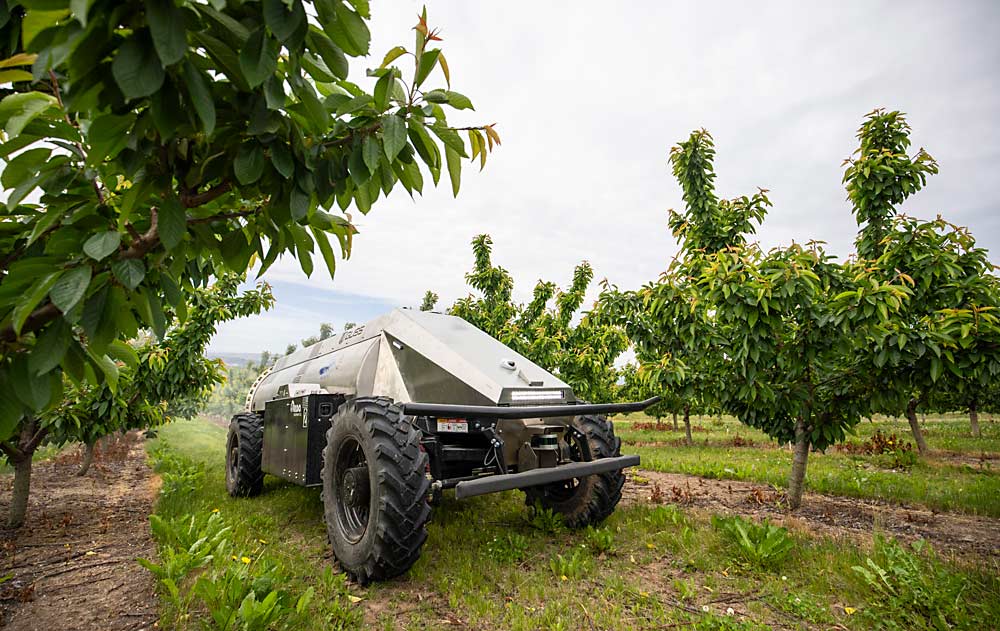
Even the horn is automated.
As the Mini GUSS approached the end of each cherry row, the driverless sprayer bleated a warning beep, in case a person happened to mosey by. The GPS- and lidar-guided automated sprayer also steered itself, turned off and on its valve banks and — if anything got in its way — stopped.
Operator Bryan Monson of Monson Fruit Co. sat in a nearby pickup and mostly watched on his laptop.
“My goal is to run this from Italy,” Monson said as he demonstrated one of his family’s new missile-shaped automated sprayers for Good Fruit Grower in mid-June.
Monson is an early adopter of the Mini GUSS, or Global Unmanned Spray System, just one of the automated spray technologies making commercial headway in the tree fruit industry. Self-driving tractors, automated tank mixers and intelligent spray valves are others.
“There’s going to be something for everybody’s price point,” said Gwen Hoheisel, a Washington State University extension specialist who specializes in spray technology for the grape and tree fruit industries. In fact, Hoheisel is currently researching new innovations in Europe, because everybody across the globe is looking for ways to take people and imprecision out of spraying, and nobody has a clear-cut lead, she said.
“The whole world is going after this,” Hoheisel said.
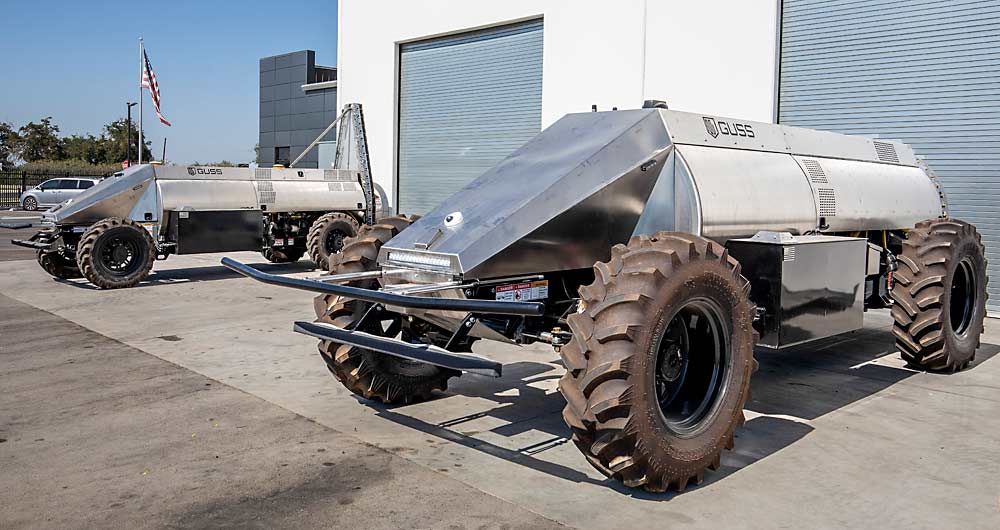
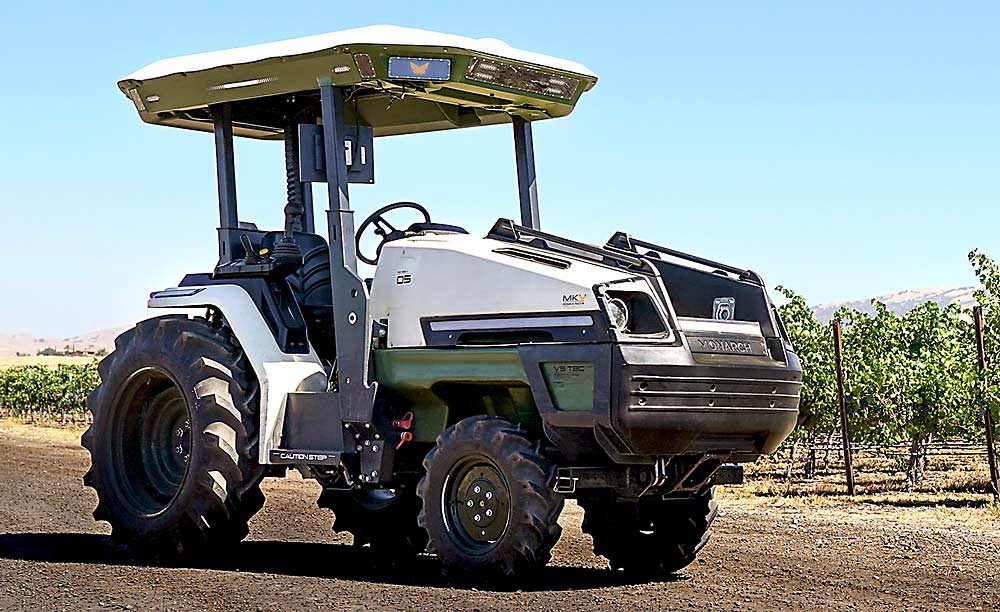
Automation in the spray world hinges on automating the driving or the spraying, Hoheisel said.
Self-driving tractors, obviously, aim for the driving.
California company Monarch Tractor has built what it calls “driver optional” electric tractors, with fruit orchards and vineyards in mind. The tractors retail for $58,000, or $68,000 for four-wheel-drive models.
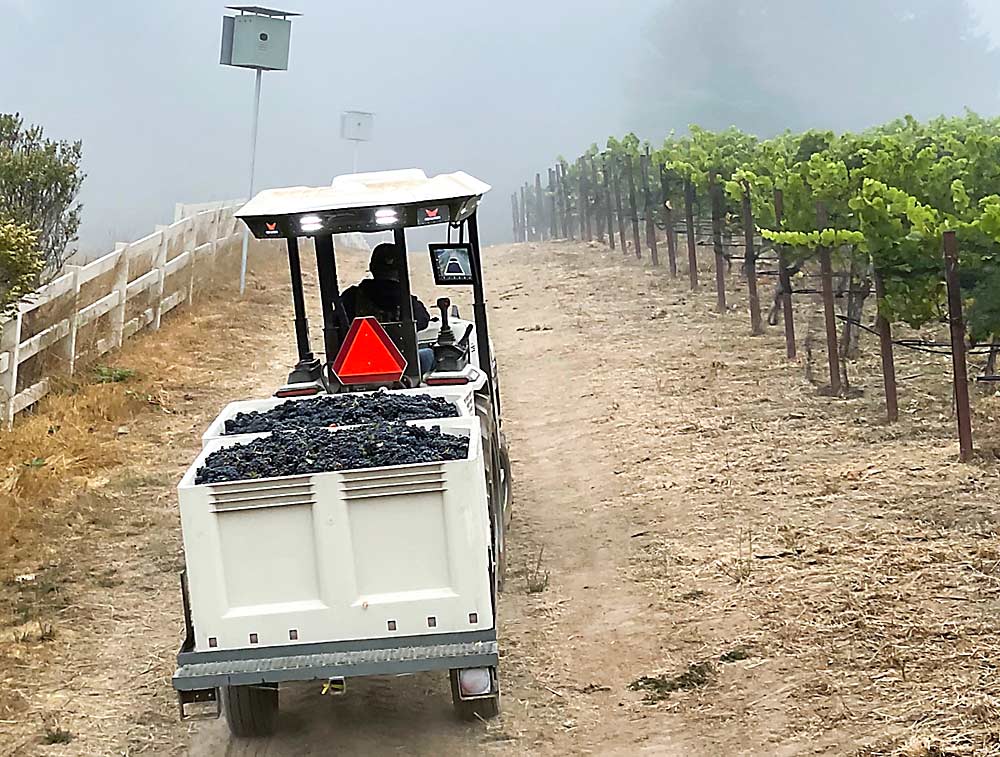
So far, Monarch has deployed only a few tractors for testing on the West Coast through a grant program, including in tree fruit blocks, said Kelsey Ducker, director of marketing. The machines won’t be available for commercial purchase until later this year, though some tree fruit customers have paid a deposit.
Blue White Robotics makes a kit that converts existing tractors to remote operation. So far, the company has made commercial headway in nuts and wine grapes, said Adi Schechter, marketing director for Blue White Robotics. Tree fruit growers have shown interest but had not made any purchases as of the end of June. The Israeli-based company maintains a U.S. headquarters office in Fresno, California.
Blue White commercializes its technology as an annual service contract. After a startup cost, growers then pay for the kit through a subscription. Prices are based on farm size, number of converted tractors and other factors specific to the farm.
On the spray automation side, Smart Guided Systems of Indiana uses lidar sensors to turn nozzles on for vegetation and off in gaps. Growers in Washington are putting such technology to use commercially, Hoheisel said.
This spring, growers in The Dalles, Oregon, saw a demonstration of a tank-mixing automation system called the QuickDraw, made by SurePoint Ag Systems of Atwood, Kansas. Other growers have purchased ultraviolet-light-therapy robots for powdery mildew control in wine grapes. A variety of vendors, such as Vine Tech Equipment of Prosser, Washington, and global TeeJet Technologies, offer relatively inexpensive rate controllers that help adjust spray rates as the tractor speeds up and slows down, such as on hills, Hoheisel said.
GUSS on the ground
GUSS aims to automate both the driving and the spraying, said Gary Thompson, chief operating officer of the Kingsburg, California, company.
The vehicle drives itself, but the sprayer array will turn off automatically for end rows and for turning, based on its GPS mapping. The company also offers an option of ultrasonic sensors that will turn off banks of valves when there is no vegetation to spray. To take that further on future units, the company is collaborating with Smart Guided Systems.
“We see GUSS kind of as a perfect platform to add those types of technologies to it,” Thompson said.
GUSS has its roots in 40 years as a spray service company. Company leaders originally automated to solve their own labor shortage. Since then, their growth has been in making and selling automated sprayers to nut and citrus growers, Thompson said.
At winter trade shows, the company unveiled the Mini GUSS, a vehicle designed for the narrower rows of the Northwest’s trellised tree fruit, wine grape and blueberry farms. It’s 6 feet wide, 19 feet long and 5 feet, 4 inches tall, without a vineyard or orchard spray tower, and holds 400 gallons instead of 600.
Earlier this year, the company launched a joint venture with tractor giant John Deere, in which GUSS will produce the sprayers and innovate design, while John Deere helps fill sales channels. RDO Equipment Co. and Papé Machinery represent the GUSS sprayers up and down the West Coast.
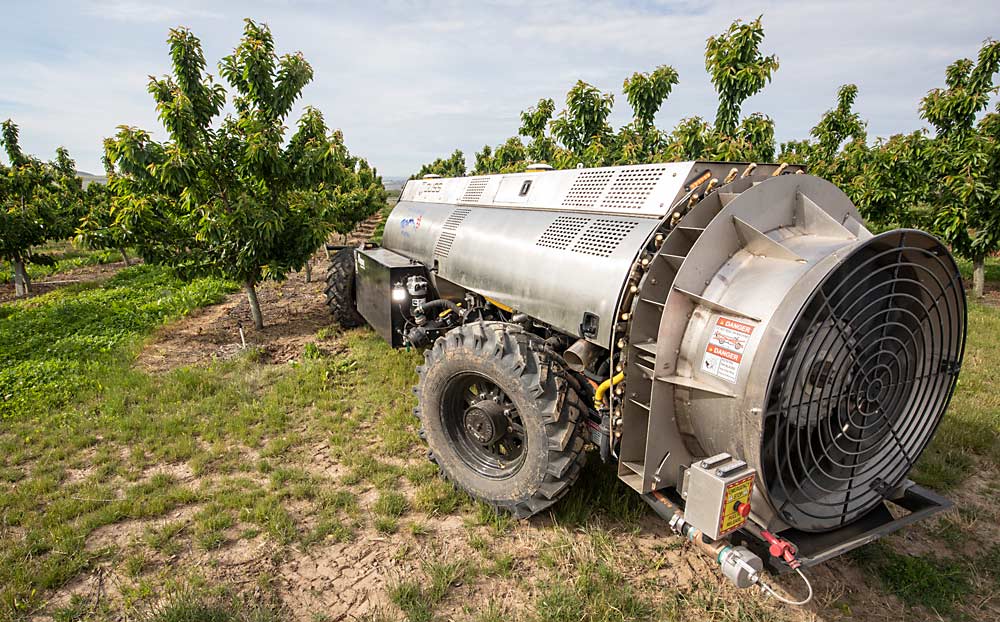
As of late June, Monson and a couple of other customers in the Northwest had purchased Mini GUSS sprayers for use in cherries, apples and pears, said Dave Del Moro of RDO. Monson was still testing the GPS at the time, but other customers had used the units with chemicals.
The idea is that one operator manages a fleet of up to eight sprayers from one laptop. Another operator drives a nurse truck to refill the sprayers with fuel and chemicals in the field. Each GUSS uses lidar and GPS mapping to drive and spray independently, with the operator able to adjust any or all of the units with a few clicks. An emergency shutdown button shines bright red on the screen, just in case. They also can be driven by a remote, much like a video game.
Barriers to entry
For growers still hesitant, a startup cost of $300,000 per GUSS and its range of use are chief among their concerns.
“That’s a toughie,” said Jason Matson of Matson Fruit Co. in Selah, Washington. “And you can’t use it for anything else.”
Gilbert Plath of Washington Fruit and Produce Co. of Yakima, Washington, leans toward automating tractors and keeping his conventional sprayers.
“We’re replacing a tractor, so we want it to do everything a tractor does,” he said.
Thompson has heard that complaint. Someday ag automation will come up with a “Swiss Army Knife” for multiple tasks, but that’s unrealistic now, he said. Besides, many customers don’t ever unhook sprayers from tractors anyway, he said. GUSS advertises a return on investment in, at most, three years for California nut growers spraying eight times a year. Tree fruit growers spray 30 or more times a year on smaller rows, he said.
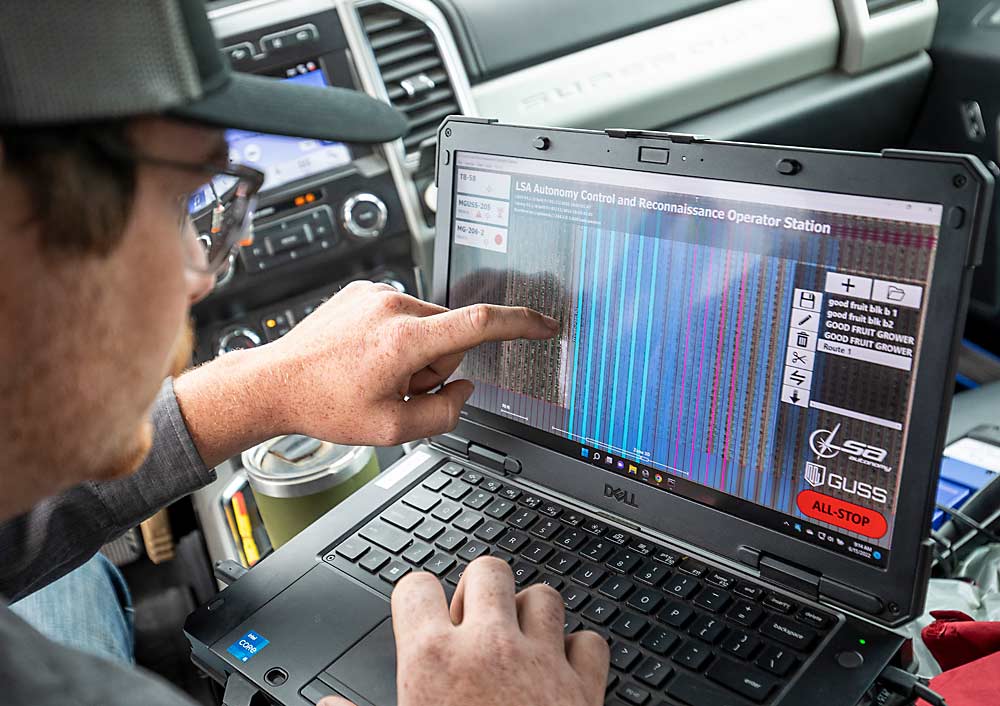
That’s what sold Monson Fruit. The Yakima company has ordered four Mini GUSS units because the company has a lot of apples and cherries that need a lot of spraying.
“We’re spraying all the time,” Bryan Monson said.
The automated units won’t replace any employees, he said. The existing operators will either learn to use GUSS, be reassigned to other duties or drive tractors to spray areas GUSS can’t reach. The machines can climb hills but struggle to stay in the center of rows on side slopes. GUSS is working on a crab steering system to improve that for future iterations. Monson is testing the sprayers in hilly areas but intends to mostly use them in the flat Columbia Basin near Quincy.
“This is automation finally reaching the fields,” Monson said. •
—by Ross Courtney

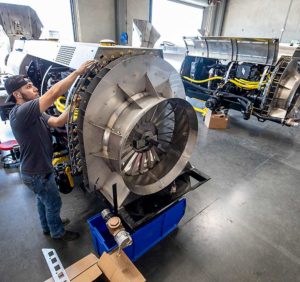
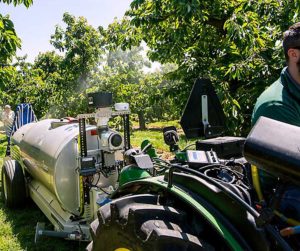
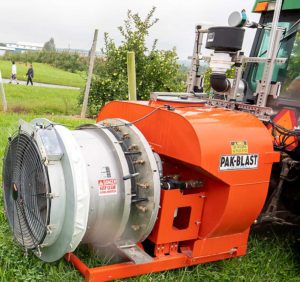
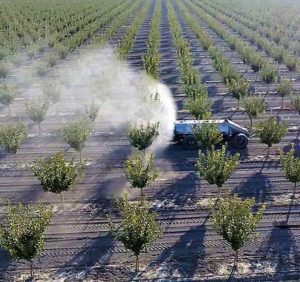
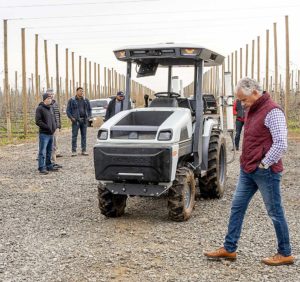





Leave A Comment